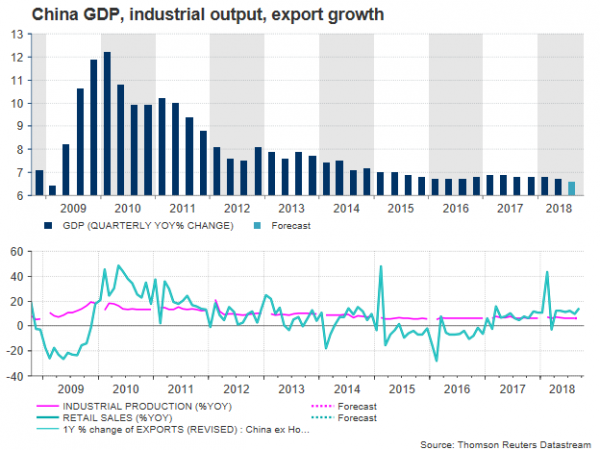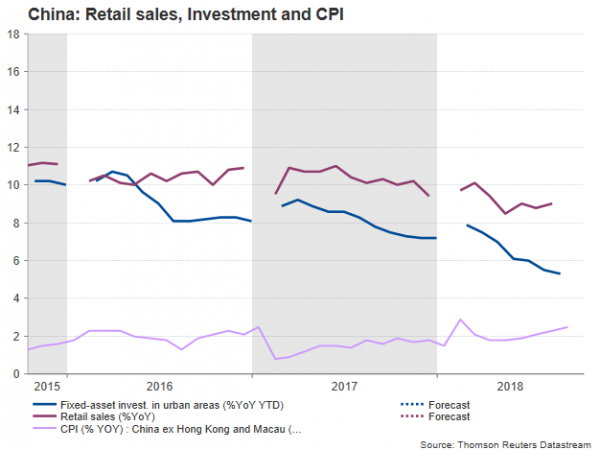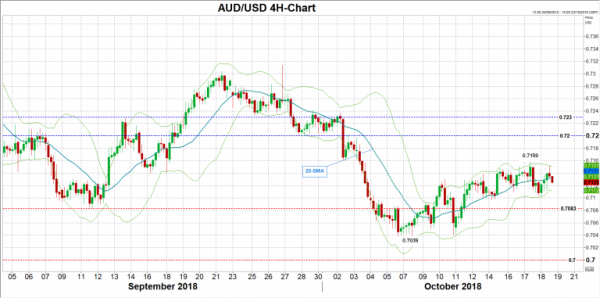China is due to report GDP growth for the third quarter on Friday at 0200 GMT alongside figures on industrial production, retail sales and fixed asset investment. While it is relatively early to identify tariff consequences from the ongoing US-Sino trade war, analysts believe that the world’s second biggest economy has already started to show signs of slowing down in the face of trade uncertainties.
In the three months to June, China’s National Bureau of Statistics found that economic growth in the country softened to 6.7% year-on-year from 6.8% in the preceding quarter, as the government tightened credit controls to put breaks in the massive debt growth, dragging the property market lower. Industrial production in the second quarter was also on the back foot, as fears over a more intensive tit-for-tat game between Washington and Beijing increased after the US imposed tariffs on steel (25%) and aluminium (10%) in January and unleashed fresh levies on $50 billion Chinese imports in June.
In the third quarter, analysts believe that conditions deteriorated even further, with GDP growth seen weaker at 6.6%, at the lowest since roughly the financial crisis. Still, it is worthy of mention that this would keep on track the government’s annual target for growth of 6.5%.
Forecasts for factory output are less encouraging too, with the gauge estimated at 6.0% y/y in September, compared to 6.1% in August. Having said that, Chinese producers seem to have been holding up well in foreign markets according to September’s trade stats, although some of them, especially in the manufacturing sector, have already expressed fears that sooner or later US import tariffs may dry orders from the US mainland.
But for now, it looks like a depreciating offshore yuan keeps Chinese products competitive abroad, with exports advancing by 14.5% y/y in September, the fastest since March. Also of note, China’s trade surplus with the US hit a record high of $34 billion in September. Note that the offshore yuan lost around 6.0% of its value against the greenback since the start of the year. Yet some economists support that the spike in trade numbers was a matter of front-loading, as firms act to avoid the implementation of a 10% US tariff on an additional $200 billion Chinese products on September 24. It is also worth noting that a measure of new export orders in the Caixin manufacturing PMI dropped to 48 last month, below the 50 threshold which separates growth from contraction, a sign that the US protectionism has already started to weigh on activity.
Despite US actions, Beijing is not giving in to pressure, taking counter-measures to fight back. Moreover, fearing the negative effects of trade barriers have still to be felt, the People’s Bank of China decided to inject liquidity in the economy by cutting the amount banks required to hold as reserves for the fourth time this year with the latest cut coming in on October 15.
Also of importance will be September’s retail sales. Those are forecasted to grow by 9.0% y/y, the same as in August.
Outside households, the expansion rate in infrastructure investments which were once used to shore up the economy, tumbled to a historic low of 5.3% in the January-August period. In September, the gauge is anticipated to again expand by 5.3% y/y in the year-to-date, reflecting the government’s efforts to curb public expenses to keep debt levels in check.
Looking at aussie/dollar, that tends to be sensitive to economic developments in China which is the number one buyer of Australian products, the pair has been rising steadily after the rebound on the 2 ½-year low of 0.7039 on October 8. A surprisingly weaker Chinese economy on Friday could pressure AUDUSD towards the lower Bollinger band currently standing at 0.7112, while under that level the bears could rest around 0.7083; this area acted as support in the past. In case this fails to halt downside movements too, all eyes will turn to the 0.7039 bottom. A significant violation at this point would turn the market even more bearish, bringing the 0.7000 round level under the radar.
In the alternative scenario in which GDP growth rises above expectations, the aussie may retest the previous peak of 0.7159 which is marginally above the upper Bollinger band. A rally towards the 0.7200 key level that provided both support and resistance in recent months could also come into view if the figures impress even more, while 0.7230 may be another potential resistance to keep in mind.















